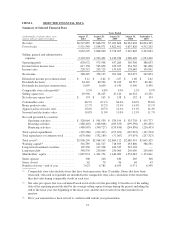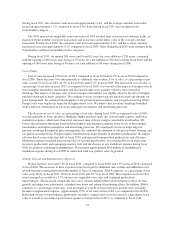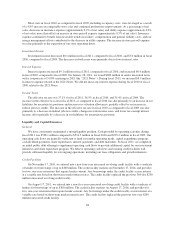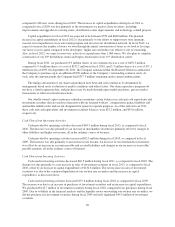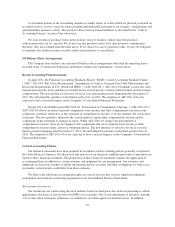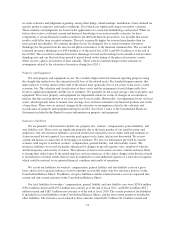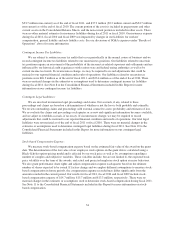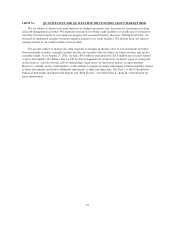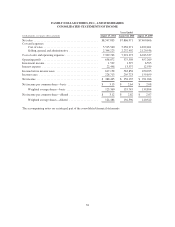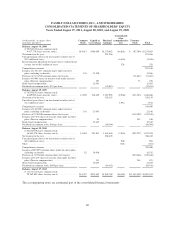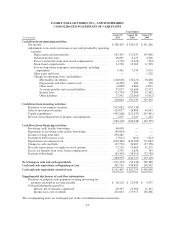Family Dollar 2011 Annual Report Download - page 36
Download and view the complete annual report
Please find page 36 of the 2011 Family Dollar annual report below. You can navigate through the pages in the report by either clicking on the pages listed below, or by using the keyword search tool below to find specific information within the annual report.A substantial portion of the outstanding amount of standby letters of credit (which are primarily renewed on
an annual basis) is used as surety for future premium and deductible payments to our workers’ compensation and
general liability insurance carrier. We accrue for these future payment liabilities as described in the “Critical
Accounting Policies” section of this discussion.
We issue inventory purchase orders in the normal course of business, which represent purchase
authorizations that can be canceled. We do not consider purchase orders to be firm inventory commitments;
therefore, they are excluded from the table above. If we choose to cancel a purchase order, we may be obligated
to reimburse the vendor for unrecoverable outlays incurred prior to cancellation.
Off Balance Sheet Arrangements
The Company does not have any material off balance sheet arrangements other than the operating leases
included in the “Contractual Obligations and Other Commercial Commitments” section above.
Recent Accounting Pronouncements
In April 2011, the Financial Accounting Standards Board (“FASB”) issued Accounting Standard Update
(“ASU”) 2011-04 “Fair Value Measurement: Amendments to Achieve Common Fair Value Measurement and
Disclosure Requirements in U.S. GAAP and IFRSs” (“ASU 2011-04”). ASU 2011-04 amends current fair value
measurement and disclosure guidance to include increased transparency around valuation inputs and investment
categorization. The new guidance is effective for fiscal year and interim periods beginning after December 15,
2011. We will adopt this guidance in the third quarter of fiscal 2012. The adoption of ASU 2011-04 is not
expected to have a material impact on the Company’s Consolidated Financial Statements.
In June 2011, the FASB issued ASU 2011-05 “Presentation of Comprehensive Income” (“ASU 2011-05”).
ASU 2011-05 allows an entity to present components of net income and other comprehensive income in one
continuous statement, referred to as the statement of comprehensive income, or in two separate, but consecutive
statements. The new guidance eliminates the current option to report other comprehensive income and its
components in the statement of changes in equity. While ASU 2011-05 changes the presentation of
comprehensive income, there are no changes to the components that are recognized in net income or other
comprehensive income under current accounting guidance. The new guidance is effective for fiscal year and
interim periods beginning after December 15, 2011. We will adopt this guidance in the third quarter of fiscal
2012. The adoption of ASU 2011-05 is not expected to have a material impact on the Company’s Consolidated
Financial Statements.
Critical Accounting Policies
Our financial statements have been prepared in accordance with accounting policies generally accepted in
the United States of America. Our discussion and analysis of our financial condition and results of operations are
based on these financial statements. The preparation of these financial statements requires the application of
accounting policies in addition to certain estimates and judgments by our management. Our estimates and
judgments are based on currently available information, historical results and other assumptions we believe are
reasonable. Actual results could differ from these estimates.
We believe the following accounting principles are critical because they involve significant judgments,
assumptions and estimates used in the preparation of our Consolidated Financial Statements.
Merchandise Inventories:
Our inventories are valued using the retail method, based on retail prices less mark-on percentages, which
approximates the lower of first-in, first-out (FIFO) cost or market. We record adjustments to inventory through
cost of sales when retail price reductions, or markdowns, are taken against on-hand inventory. In addition,
32



